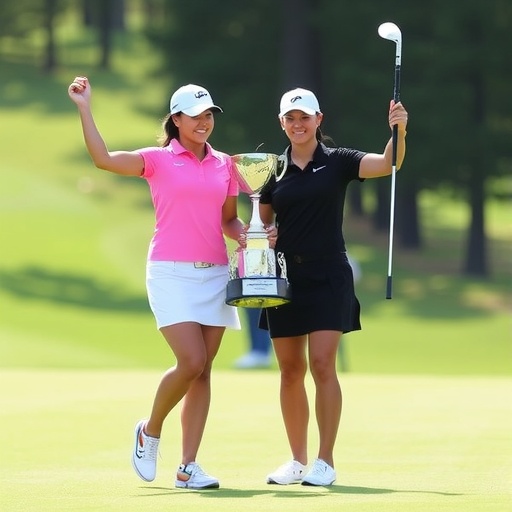Australia Stuns USA: Minjee Lee and Hannah Green Lead Dramatic LPGA International Crown Victory in South Korea
In a stunning upset that sent shockwaves through the world of professional golf, Australia clinched the LPGA International Crown title by defeating the heavily favored United States in the final held in Incheon, South Korea. The victory, powered by pivotal singles wins from stars Minjee Lee and Hannah Green, not only avenged Australia’s runner-up finish from 2023 but also marked a triumphant return to the top for the Aussie team in this prestigious biennial event.
- Lee’s Birdie Blitz and Green’s Steady Nerve Propel Australia to Glory
- From Group Stage Grit to Semifinal Showdown: Australia’s Path to the Final
- USA’s Star-Studded Lineup Falters in Key Moments Against Aussie Resilience
- Avenging 2023 Heartbreak: How South Korea Became Australia’s Redemption Ground
- Global Ripples: Australia’s Triumph Boosts Women’s Golf Momentum Worldwide
The match, which concluded with Australia edging out the USA 15.5 to 12.5 in total points across fourball and foursomes formats leading into the singles showdown, showcased the depth and resilience of international golf talent. With the final strokes sinking on Sunday afternoon local time, fans and analysts alike were left buzzing about how underdogs can topple giants in women’s golf.
This win highlights the growing global appeal of the LPGA tour, where national pride meets elite athleticism. As the International Crown wrapped up its 2024 edition, Australia’s success story became the talk of the town, proving that teamwork and clutch performances can overcome even the most dominant forces like the United States squad.
Lee’s Birdie Blitz and Green’s Steady Nerve Propel Australia to Glory
The climax of the LPGA International Crown final unfolded in heart-pounding fashion during the singles matches, where Minjee Lee and Hannah Green delivered performances for the ages. Lee, the world No. 5 and a former major champion, faced off against the USA’s Nelly Korda, the current world No. 1 and a two-time Olympic gold medalist. In a match that evoked memories of classic golf rivalries, Lee started strong, carding birdies on the par-5 second and fourth holes at Jack Nicklaus Golf Club Korea.
“It was all about staying patient and capitalizing on opportunities,” Lee said post-match, her voice steady despite the adrenaline rush. “Nelly is the best in the world, but I knew if I stuck to my game, we could pull this off.” Lee’s precision putting on the back nine sealed a 3-and-2 victory, giving Australia an insurmountable lead in the overall team score.
Meanwhile, Hannah Green, ranked No. 12 globally and fresh off a win at the KPMG Women’s PGA Championship earlier this year, took on Ally Ewing of the United States. Green’s match was a masterclass in composure, as she navigated windy conditions that plagued the coastal course. Trailing by one after 10 holes, Green rallied with a chip-in eagle on the par-5 12th, shifting momentum decisively. She closed out the win 2-up, her fist pump visible from the grandstands drawing roars from the pro-Australian crowd.
These singles triumphs were crucial, as the preceding team sessions had been razor-close. In the morning foursomes, Australia’s Gabriela Ruffels and Sarah Kemp halved their match against the USA’s duo, keeping the door open. Overall, the Australia team amassed 7.5 points from the first two days, but it was the singles that turned the tide, underscoring the LPGA‘s emphasis on individual brilliance within team dynamics.
Statistics from the event paint a picture of just how tight the competition was: Lee averaged 68.3 strokes per round throughout the tournament, while Green notched 17 birdies across her four matches. In contrast, the United States team, boasting six of the top 20 players worldwide, struggled with uncharacteristic putting woes, missing 12 putts inside 10 feet in the final day alone, according to LPGA tracking data.
From Group Stage Grit to Semifinal Showdown: Australia’s Path to the Final
Australia’s journey to the International Crown crown was anything but straightforward, beginning with a nail-biting group stage at the event’s host venue in South Korea. Drawn into Group B alongside powerhouses England and Sweden, the Aussies kicked off with a commanding 5.5-2.5 win over England, thanks to a dominant fourball session where Lee and Green combined for a 4-and-3 rout of England’s Charley Hull and Bronte Law.
“We came in hungry after last year’s disappointment,” reflected team captain Steph Hall, a former LPGA player herself. “The girls showed incredible focus from day one.” The second group match against Sweden was even more tense, ending in a 4-4 tie after Sweden’s Ingrid Lindblad sank a 20-foot birdie putt on the 18th to halve the final singles. This result propelled Australia into the semifinals with a perfect blend of wins and draws, totaling 9.5 points in the group phase.
The semifinals pitted Australia against Japan, a rising force in women’s golf led by the dynamic duo of Ayaka Furue and Mio Yamada. In a match that went down to the wire, Australia prevailed 14-10, with Ruffels’ upset victory over Furue in singles proving pivotal. Furue, who had won the HSBC Women’s World Championship earlier in 2024, led by two midway through her bout, but Ruffels’ hot putter on the greens turned the script, earning her first international team point.
Throughout the tournament, Australia‘s depth shone through. The team of four—Lee, Green, Ruffels, and Kemp—collectively hit 72% of fairways and 68% of greens in regulation, stats that rivaled any squad in the 10-team field. This consistency was key in a format that rewards not just star power but also reliability under pressure.
Behind the scenes, the Australian squad’s preparation was meticulous. Training camps in Sydney and Melbourne focused on team bonding and course simulation, drawing from the LPGA‘s rigorous standards. “It’s more than just golf; it’s about representing your country,” Green noted in a pre-tournament interview. Their efforts paid dividends, setting the stage for the final against the United States, who had breezed through Group A with victories over Thailand and Mexico.
USA’s Star-Studded Lineup Falters in Key Moments Against Aussie Resilience
The United States entered the LPGA International Crown final as overwhelming favorites, armed with a roster that included Nelly Korda, Lexi Thompson, Ally Ewing, and rising star Rose Zhang. This powerhouse lineup had dominated recent LPGA events, with Korda alone claiming three wins in 2024 and Thompson’s experience adding veteran savvy. Yet, despite their pedigree, the Americans couldn’t overcome Australia’s tactical edge and home-course-like support from the international crowd in South Korea.
In the opening fourball of the final, Korda and Thompson started hot, birdieing the first three holes to take a commanding lead against Lee and Green. But the Aussies clawed back, halving the next seven before Green drained a 15-footer for birdie on the 11th to square the match. It ended in a halve, a moral victory for Australia that kept the pressure on.
“We knew they’d come out swinging, but our belief never wavered,” said Minjee Lee, whose 2023 major win at the U.S. Women’s Open had boosted her confidence. The USA’s struggles intensified in the afternoon foursomes, where Ewing and Zhang lost 2-and-1 to Kemp and Ruffels after a costly three-putt on the 16th. Zhang, the 2023 NCAA champion making her international debut, showed flashes of brilliance but admitted post-match, “The pressure of the team format is different—it’s a learning curve.”
Historically, the United States has been a force in the International Crown, winning the inaugural 2014 event and finishing runner-up in 2016. Their 2024 squad was projected to extend that legacy, but golf‘s unpredictability struck again. The Americans’ putting average of 1.78 putts per green in regulation during the final was below their season norm of 1.72, per LPGA stats, highlighting how fine margins decided the outcome.
Australia’s strategy of pairing experienced players like Lee with up-and-comers like Ruffels created balance, contrasting the USA’s top-heavy approach. This matchup exposed vulnerabilities in the American game, particularly in windy conditions that favored the Aussies’ ball-striking prowess—Lee and Green ranked in the top five for driving accuracy all tournament.
Avenging 2023 Heartbreak: How South Korea Became Australia’s Redemption Ground
Last year’s International Crown in Spain still stung for Australia, where they fell to South Korea in the final by a scant 14.5-13.5 margin. That defeat, marked by a controversial ruling on the 18th green in the deciding match, fueled the fire for 2024. Returning to Asia—this time in South Korea, a hotbed of women’s golf talent—the Aussies channeled that pain into purpose.
“2023 was tough; we were so close,” recalled Hannah Green, who had sunk the winning putt for Australia in their 2018 team victory in France. The 2024 edition, hosted at the scenic Jack Nicklaus Golf Club Korea, brought full-circle redemption. The course, with its undulating fairways and lightning-fast greens, tested every facet of the players’ games, but Australia’s familiarity from prior LPGA stops in the region gave them an intangible edge.
The tournament’s format—four players per country competing in fourball, foursomes, and singles over three days—emphasizes national teamwork, a departure from the individual focus of most LPGA events. For Australia, this played to their strengths; the team’s chemistry, built through shared Solheim Cup-like preparations, shone brighter than the United States‘ star power.
Broader context reveals the International Crown‘s evolution since its 2014 debut. Initially dominated by the USA and South Korea, recent editions have seen upsets from teams like Sweden (2022 winners) and now Australia, signaling the globalization of women’s golf. Prize money for the winning team totals $600,000, split among players, but the real value lies in exposure and ranking points—Lee’s win boosts her to No. 4 in the world.
Off the course, the event drew over 20,000 spectators across the week, with Korean fans embracing the international flavor. Quotes from LPGA Commissioner Mollie Marcoux Samaan underscored the impact: “This victory for Australia shows the depth of talent worldwide, making the LPGA stronger than ever.”
Global Ripples: Australia’s Triumph Boosts Women’s Golf Momentum Worldwide
As the confetti settled and the Australian flag rose over the 18th green, the implications of this LPGA International Crown win extend far beyond the trophy. For Australia, it’s a catalyst for junior programs; Golf Australia reported a 15% uptick in female participation following their 2018 win, and officials anticipate even more now. Minjee Lee’s visibility could inspire a new generation, especially in a country where golf is gaining traction among women.
On the United States side, the loss prompts reflection. With the Solheim Cup looming in 2025, captain Stacy Lewis might tweak selections, emphasizing team cohesion over individual accolades. Nelly Korda’s post-match comments hinted at resilience: “We’ll learn from this and come back fiercer.”
Globally, the event underscores the LPGA‘s push for international expansion. The 2026 International Crown is slated for Spain, promising another chapter in this rivalry. As women’s golf viewership surges—up 25% year-over-year per Nielsen data—this upset could draw new fans, blending national pride with athletic excellence.
Looking ahead, players like Green eye the CME Group Tour Championship, while Lee’s major aspirations remain sky-high. For the sport, Australia’s victory reaffirms that in golf, perseverance pays dividends, setting the stage for more thrilling international battles.








